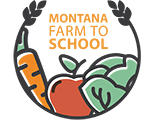Resources
Getting Started
Farm to school programming looks different in each community and school depending on available resources, goals, and interests. These steps will help you form a farm to school program.
Download: Printable Steps to Farm to School Fact Sheet
Adapted from: USDA Farm to School Planning Toolkit
Also check out: Getting Started with Farm to School Fact Sheet
Learn from Montana communities: Montana Regional Farm to School Guide: A Story of Growing Farm to School in Two Communities
Building a team is a critical first step and is essential to the long-term success of your program. It's an opportunity to create allies, bring in knowledge and expertise, and recruit some boots on the ground for planning and implementing your program. Consider including: administration, teachers, parents, facilities staff, community members, Extension Agents, etc.
Assess where you currently are so you know where to start. What do you want to achieve with your farm to school program? Establishing short and long-term goals will help keep your program on track.
Helpful Resources:
• Farm to School Assessment – Georgia Organics
• Farm to School Evaluation Toolkit – Colorado Farm to School
• Farm to School Census – USDA
For program success and sustainability consider including all three farm to school "core elements" in your program—local food procurement, school gardens, and education:
Procurement: Before you start purchasing local foods or determine which local foods you are already purchasing, you must determine what foods are grown, harvested, raised, caught, and processed in the region and when those foods are available.
When local foods are being procured using federal meal program funds, those purchases must be done in accordance with regulations.
Learn more on the School Food resource page.
School Gardening: Consider how you want the gardens to be used; what types and how much food you hope to produce; where to locate the gardens; how to design the gardens; what tools and materials you'll need; how much funding and staff support is needed; and what you'll do with the harvest.
Learn more on the School Garden resource page.
Education & Curriculum Integration: What kinds of food, agriculture, and nutrition-related educational activities you will engage students in? How can you connect new foods in the cafeteria with educational opportunities?
Learn more on the Food Education K-12 or Farm to Preschool resource pages.
Maintaining food safety is essential to every school meal program. Gardening and local purchasing may present some new food safety questions and require new protocols.
Helpful Resources:
• Montana Farm to Cafeteria Manual
• School Garden Food Safety – USDA and NFSMI
• Contact your County Sanitarian
Key to getting buy-in and support for your farm to school program is clearly communicating your goals, achievements, and needs.
Helpful Resources:
• Montana Menu Boards – Montana Team Nutrition
• Montana Harvest of the Month
• Ideas for Promoting Farm to School – USDA
• National and Montana Farm to School Month
• Montana Crunch Time
Evaluation findings can help you learn what works, improve your program, and demonstrate your success to funders, parents, administrators, and others.
Helpful Resources:
• Farm to School Evaluation Toolkit
• Farm to School Census – USDA
The sustainability of your program should be an important consideration throughout your planning process. As your program expands, a solid plan for growing and maintaining resources, donations, and policy support will ensure that your program becomes part of the fabric of your district.
Helpful Resources:
Finding Resources
There is an astonishing amount of farm to school resources these days. We have curated resources from Montana and beyond to help your start or grow your farm to school projects and organized them by topic:
- School Food
- School Gardens
- Food Education K-12
- Farm to Early Care and Education
- Montana Crunch Time
- Montana Farm to School Month
- Trainings & Events
What is Your Role?
Strong and diverse teams are both essential to and one of the many benefits of successful farm to school projects consisting of everyone from farmers to teachers to parents and beyond. While the backbone of farm to school programs are very similar, your role may be very different. Click on your role below for guidance and ideas tailored to your role in farm to school. Keep in mind that all farm to programs are unique to their school and community.
Food Producer
Here are a few ways you can be involved:
- With over 80,000 school lunches served every day during the school year in Montana, schools can provide a consistent, stable market for your goods. Talk with the school food service manager or head cook and/or school administration to determine if they are interested in purchasing local foods. Ask what types of products, quantity, form, packaging, and price they prefer. Learn more about the cafeteria component of farm to school at the School Food resource page.
- Offer to visit schools to give presentations about the food you grow, raise, or make. Consider bringing samples to show or for the students to taste. Be sure to ask the teacher about food allergies or school policies regarding food in the classroom or cafeteria. Learn more about opportunities in the classroom in the Food Education K-12 and Farm to Preschool resource pages.
- Farm field trips are fun and can provide valuable, hands-on learning opportunities. Field trips to your farm or food business provide a hands-on educational opportunity for students. Work with a teacher or parents to set up stations so to keep kids engaged and learning while on the farm. Learn more about opportunities for farm or food business field trips in the Food Education K-12 and Farm to Preschool resource pages.
- Become a Montana Harvest of the Month producer! Montana Harvest of the Month showcases Montana-grown and raised foods in Montana schools,
institutions, organizations, and businesses. When you register as a producer, you:
- Let participating sites know which HOM products you produce, process, or distribute.
- Receive a ‘HOM Participant’ tag on your Abundant Montana listing.
- Are added to the Producer Directory on the HOM portal, visible to all participating sites interested in increasing their local food procurement.
- Receive access to general HOM guides, strategies, and resources for making institutional sales. For more information or to register as a Harvest of the Month producer, visit mtharvestofthemonth.org.
Food Service Professional
Here are a few ways you can be involved:
- As a child nutrition professional, you are working hard to feed children nutritious food within a tight budget. By using and featuring local ingredients, you can increase participation and acceptance of meals while supporting your community! Buying local foods isn’t much different than buying food and supplies through your normal distributors. Learn more about incorporating local foods in school meals in the School Food resource page.
- Join the Montana Harvest of the Month program as a way to build or grow your farm to school program. With this program, you will feature a different Montana food each month, connect food in the cafeteria with learning in the classroom, and help promote Montana foods to students, staff, and parents. Learn more or register for Montana Harvest of the Month.
- Team up with your school to make a larger impact on children’s eating habits. Consider working with family and consumer science, culinary, or other classes to conduct taste tests of new foods, develop new recipes, or help provide youth with hands-on culinary education and experience. Your experience and the school’s commercial kitchen are valuable resources for youth interested in culinary careers or just cooking at home. Learn more about opportunities for educational opportunities in the Food Education K-12.
Educator
Here are a few ways you can be involved:
- Nutrition, agriculture, garden, and food education is a critical component of successful farm to school programs. Students are much more likely to try new foods if they have explored them first. You can make your activities as simple as reading fun food facts to as involved as planting a school garden. Food education can fit within nearly every subject. Learn more about opportunities for educational opportunities in the Food Education K-12 resource page.
- Join the Montana Harvest of the Month program as a way to build or grow your farm to school program. With this program, your school will feature a different Montana food each month, connect food in the cafeteria with learning in the classroom, and help promote Montana foods to students, staff, and parents. Learn more or register for Montana Harvest of the Month.
- Grow a school garden. Research shows that garden based education is an effective tool for teaching many subjects and improving fruit and vegetable consumption. School gardens range from small containers kept inside the classroom to school farms that include livestock. Work with your school to find what will work for you. Learn more about growing a school garden in the School Garden resource page.
Parent or Supporter
Parents, community members, and partner organizations are an important piece of the farm to school puzzle. You can help get practices started or growing. Here are a few ways you can be involved:
- Start a farm to school committee. Farm to school programs are most successful when there is a strong team in place that includes all the key stakeholders including: school food service, teachers, administration, custodial and grounds staff, producers, parents, and community members. Set an action plan with your team and have regular meetings to check progress, discuss challenges, and celebrate successes.
- Grow a school garden. Research shows that garden based education is an effective tool for teaching many subjects and cultivating adventurous eaters with healthy eating habits. School gardens range from small containers kept inside the classroom to school farms that include livestock. You can help start or manage a school garden committee to keep up momentum and communication. Gardens need a lot of helping hands, consider helping to maintain the garden during the school year and the summer. Teaching outdoors is often easier when you have help. Ask teachers if they would like assistance with conducting school garden activities. Learn more about growing a school garden in the School Garden resource page.
- Lead taste tests and other farm to school activities. Taste tests are an effective way to encourage kids to try new foods or to test recipes. They take extra time and usually need extra help. Work with a teacher or the school food service staff to determine what is feasible, set a schedule, and start testing! Learn more about taste tests in the School Food resource page.
- Are your kiddos in preschool or attend child care? Farm to early care and education (aka farm to preschool) is a growing movement and is a fun way for little fingers to explore food, nutrition, and agriculture and tiny taste buds to try new healthy foods. Ask your child care site or preschool if they can implement any of the farm to school concepts—procurement, gardens, or food education. Learn more in the Farm to Preschool resource page.
- Help celebrate farm to school with a fun event or fundraiser! October is National and Montana Farm to School Month, a great time to showcase local foods. Montana Crunch Time, held on one day every year in October is a statewide event during which all Montanans are encouraged to crunch into a locally or regionally grown apple! Learn more about Montana Crunch Time and Montana Farm to School Month.
- Build a team and join the Montana Harvest of the Month program as a way to build or grow your farm to school program. With this program, your school will feature a different Montana food each month, connect food in the cafeteria with learning in the classroom, and help promote Montana foods to students, staff, and parents. Learn more or register for Montana Harvest of the Month.


